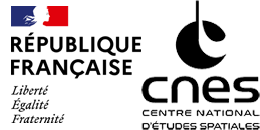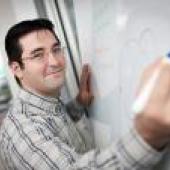|
Start Time |
End Time |
Content |
Speakers |
|
14:00 |
14:15 |
Welcome - Seminar Introduction |
S. Laurens (CNES), S. Locoche (ADS), J. Laurent-Varin (CNES), A. Boutonnet (ESOC) |
|
14:15 |
14:45 |
ASTERIA Autonomous Collision Risks Management |
J. Thomassin (CNES) |
|
14:45 |
15:15 |
Reducing Operation Cost with Autonomous Guidance for Electrical Orbit Raising |
S. Locoche (ADS) |
|
15:15 |
15:45 |
Close Satellite Formation Flying For An Interferometry Mission |
Irene Valenzuela Molina (CNES) |
|
15:45 |
16:00 |
Break |
|
|
16:00 |
16:30 |
Trajectory Design using Lyapunov Control Laws and Reinforcement Learning |
H. Holt (PhD candidate - Surrey Space Centre) |
|
16:30 |
17:00 |
The recent evolutions of the CNES navigation library BOLERO |
N. Delong (CNES) |
|
17:00 |
17:30 |
Open discussion and conclusions |
S. Laurens (CNES), S. Locoche (ADS), J. Laurent-Varin (CNES), A. Boutonnet (ESOC) |
1. ASTERIA Autonomous Collision Risks Management (Jérôme Thomassin – CNES)
Developing Flight Dynamics techniques and algorithms to ensure high level of autonomy for next generation of space missions is one of the main objectives of the flight dynamics department in CNES. One example of these autonomous techniques is the Autonomous Orbital Control (AOC) which consists of delegating to onboard satellite system the identification, planning and realization of orbital corrections allowing to stay in the mission reference orbit. For several years, ASTERIA, a concept of on-board autonomy combining station keeping and collision risk management for the low earth orbit (LEO) satellites, has been developed by CNES. ASTERIA, acronym for Autonomous Station-keeping Technology with Embedded collision RIsk Avoidance system, enables both in-track and cross-track control for different LEO missions. To ensure the accuracy and reactivity of the autonomous control, the solution developed by CNES integrates the complete management of the risk of collision. Station-keeping and avoidance maneuvers are therefore closely linked by an on-board management.
Managing the risk of collision requires the best possible knowledge of the future trajectory of the primary satellite and up-to-date information on secondary objects. Thereby a calculation process with a large amount of data and the propagation of orbital states and covariance is required. That is why, so far, the collision risk management has always been a ground segment activity. But this severely limits the autonomy on board by imposing a schedule and the knowledge of the station keeping maneuvers which are not compatible with reactivity needed by an Autonomous Orbit Control (AOC). On the contrary, management by the satellite itself offers interesting prospects for reactivity and increased autonomy, but requires carrying out a risk calculation on board and identifying the relevant risk assessments to implement effective avoidance solutions onboard.
The presentation aims to show the exhaustiveness of the ASTERIA concept. First of all, the principles of collision risk management on board are described. Then, the study of the
computational load, the accuracy of the risk estimate and the performance of risk avoidance strategies are presented. The ability to the operations of such a system is then demonstrated by introducing the associated operational management process. CNES took advantage of new on-board architecture on ESOC OPS-SAT 3-Units CubeSat demonstrator to experiment the feasibility and good reliability of its AOC. This presentation will illustrate some results of this innovative experience. Finally, issues related to an autonomous system will be discussed, in particular those concerning the space traffic management
2. Reducing Operation Cost with Autonomous Guidance for Electrical Orbit Raising (Slim Locoche – Airbus Defence and Space)
In the context of electrical orbit raising, a fast and simple low-thrust transfer optimization method capable of providing reliable mission analysis outputs with high computational efficiency is critical. To this end, a dedicated method based on Lyapunov feedback control (called ΔV-Law in reference to the commonly used Q-Law) was developed within Airbus Defence and Space. The algorithm provides solutions to the low-thrust orbit transfers, including perturbations and taking into account power constraints. The proposed formulation enables to compute minimum time and minimum propellant mass problems with a limited number of optimization parameters and is fully analytical. This makes it a good candidate for mission analysis and design but also for on-board implementation which would reduce ground workload over long electrical transfers.
The proposed autonomous guidance approach is compatible with on-board resources and is encouraged by the prospect of autonomous GNSS-based navigation on-board telecom platforms. It does not require using or to stick to a reference trajectory that would be uploaded on board. This solution offers the advantage of being robust to low-thrust amplitude and direction errors and minor anomalies, offering a significant reduction in ground intervention in exchange for a minor penalty in ΔV or transfer duration compared to state-of-the-art on-ground optimizer.
3. Close Satellite Formation Flying For An Interferometry Mission (Irene Valenzuela Molina)
This mission consists of 3 nanosatellites flying in formation. The distance between the satellites in operational configuration is about 40 meters and that’s one of the challenging parts of the mission. The satellites are equipped with ISL (inter-satellite link) equipment that are used to exchange GNSS information for the maintenance of the formation with the required accuracy. Given the small inter-satellite distances and control windows, the formation will be controlled autonomously on board.
The orbit chosen for the mission is a 6h/18h quasi Sun-synchronous orbit with an altitude of about 600 km. Only the relative geometry is controlled and maintained, so the altitude of the orbit is allowed to drift freely during the mission lifetime.
The spacecraft are 6U nanosatellites, with mass close to 20 kg. They are equipped with a propulsion system delivering 0.35-0.5mN thrust. Due to power limitation, it is not possible to activate the propulsion system more than about 12 min per orbit.
The presentation will first detail the geometry of the formation, which is defined such that the satellites describe a circle in the plane perpendicular to the radial direction. The way differences in orbital elements are derived will be explained.
An important phase is the formation acquisition phase from launch to acquisition of mission configuration. The spacecraft are first operated by the ground control center until a specific relative configuration is reached when the satellites are about 5 km apart of each other. The good performance of the ISL equipment is then assessed, then the GNSS-based relative navigation system is activated, allowing to reduce progressively the inter-satellite distances. The control is then transferred to the autonomous onboard system which continues bringing the spacecraft closer and closer until the desired configuration is reached.
Specific methods are used to evaluate the trajectory that should be followed by the satellites before they reach the “5 km” target given the low thrust capability of the spacecraft. Other specific algorithms are used in the following phases, including the formation maintenance phase, which requires about 3 maneuvers per day in order to counteract the effect of perturbations and keep the geometry of the formation.
One major aspect during all the phases is collision risk, either between the satellites of the formation, or with external objects. Maneuver execution errors and failures are factors that may endanger the mission, and they require appropriate actions. The maneuver strategies that are envisioned will be presented.
4. Trajectory Design using Lyapunov Control Laws and Reinforcement Learning (Harry Holt - PhD candidate - Surrey Space Centre)
Spacecraft autonomy is a major barrier to increasing the scope, ambition, and affordability of both Earth- based and deep-space missions. The current state-of-the-art in spacecraft operations is still to guide space missions from the ground with extensive human intervention. Whilst, automated guidance, planning and trajectory design tools do exist, they often lack the vital skill of human operators, who can act under environmental and mission uncertainty.
My PhD project, titled “Trajectory Design using Lyapunov Control Laws and Reinforcement Learning (RL)”, began by trying to develop autonomous methods to enable SSTL satellites to self-drive. The goal was to develop a lightweight and closed-loop control law that can be used for both initial trajectory design and subsequent on-board guidance. In doing so, we aimed to increase the optimality and retain the stability of closed-loop feedback-driven control laws using RL methods (Proximal Policy Optimisation in particular). The motivation behind this research was to combine the stable yet sub-optimal nature of Lyapunov control laws with the exploration and state-dependence offered by RL techniques and has resulted in the development of a Reinforced Lyapunov Controller.
In this presentation I will discuss how a reinforcement learning framework can be used has to make the parameters of the Lyapunov-based Q-law state dependent, increasing its optimality. The Jacobian of these state-dependent parameters is available analytically and unlike in other optimisation approaches, can be used to enforce stability throughout the transfer. I will present brief results for GTO–GEO and LEO–GEO transfers. We will discuss time- and mass-optimal transfers, and time-allowing, explore the robustness to navigation errors and thruster misalignment using Monte Carlo analyses. We believe the resulting approach offers potential for on-board autonomous transfers and orbit reconfiguration
5. The recent evolutions of the CNES navigation library BOLERO
BOLERO stands for Bibliothèque d'Objets Logiciels Embarqués de Restitution d'Orbite, that is « on board orbit determination objects library ».
This library contains all the components to develop a GNSS orbital navigator. It has been developed by CNES since more than 20 years and has been integrated in Thales Alenia Space Topstar GPS receivers, which has already flown and is still embedded in many satellite missions using this Topstar receiver.
Recently, it was decided, due to emergence of multi-constellation GNSS receivers, to adapt the
library to be able to process any GNSS constellation measurements together. This new functionality has been integrated in the Syrlinks N-SPHERE GNSS receiver-navigator, in its bi-constellation GPS Galileo version. This receiver will be embedded in a space mission at the end of 2022.
Moreover, for the needs of the CNES mission ULID to feed a formation control module, multi-satellite and relative navigation functionalities are being developed in BOLERO.
The presentation will describe these new BOLERO functionalities, with some validation results and present the current studies and future evolutions of the library.
Open discussion and conclusions
An open discussion will conclude the seminar during which participants are invited to send a one slide summary of their current/future activities related to on-board autonomy in Flight Dynamics. A slot of 2 minutes will be allocated for each participant to present the one-page slide, followed by an open discussion. We look forward to your participation! (slides can be sent to the following email address COMET-CORB before the February 10th 12:00 CET).





